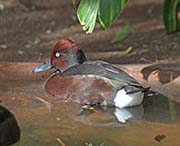Ferruginous Duck - Aythya nyroca
| Length | |
| Wingspan | |
| Clutch Size | |
| Chicks at birth | |
| IUCN Conservation Status | |
Continents: |
The Ferruginous Duck is a diving duck. The old name for this bird is White-eyed Pochard. Ferruginous Ducks are social and form large flocks in winter.
The male is reddish chestnut head, neck and breast and slightly paler flanks. with a dark back and a yellow eye. The undertail is white with white wing bars. The female is similar but is somewhat lighter and duller and the eyes are brown. Juveniles are similar looking to the female with only a slightly reddish cast to their feathers.
At one time, these ducks were widespread and plentiful in Europe and Asia. They have suffered a significant decrease in population. their IUCN conservation status is 'Near Threatened'.
Diet: Ferruginous Ducks feed by diving or dabbling. They eat aquatic plants, mollusks, aquatic insects and small fish. They often feed at night.
Courtship: Ferruginous Ducks have three courtship calls and various movements. The movements include head-throwing and a kinked-neck display.
Nesting: They breed in marshes and lakes and lay 7-11 eggs The nests are usually close to water, often on floating mats of aquatic vegetation.
Habitat and Range: Breeds in Southern and Eastern Europe and southern and western Asia. They migrate in winter to the Mediterranean and as far south as Northern Africa. They live in marshes, lakes and ponds.
Vocalization: Ferruginous Ducks do not vocalize a lot except during courtship.
Plumage/Molt Male Ferruginous Ducks have an alternate or breeding plumage. The male's alternate plumage is described above and the basic (non-breeding) plumage has the male resembling the female.
Tongue/feet: Legs are feet are blackish gray.
Bibliography:
- Kear, Janet, Editor, Ducks, Geese and Swans, Volume 2,Oxford University Press, 2005
- http://www.waza.org/en/zoo/ World Association of Zoos and Aquariums, Accessed June 2012
- http://en.wikipedia.org The Free Encyclopedia, Accessed June 2012




